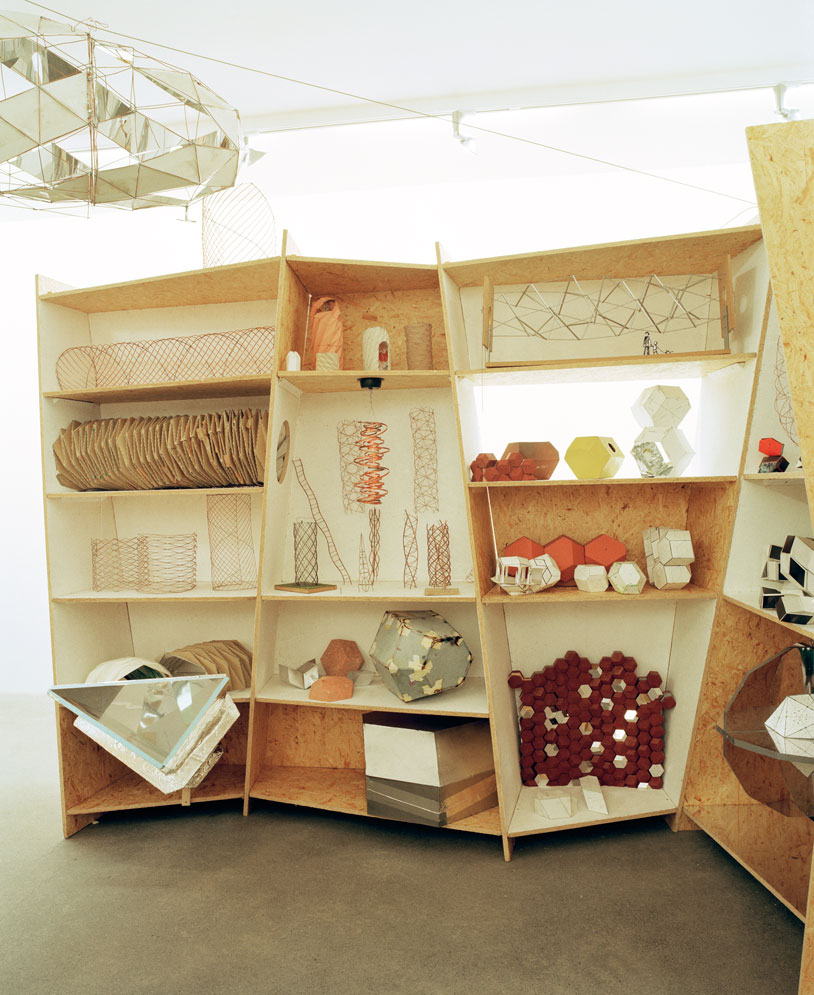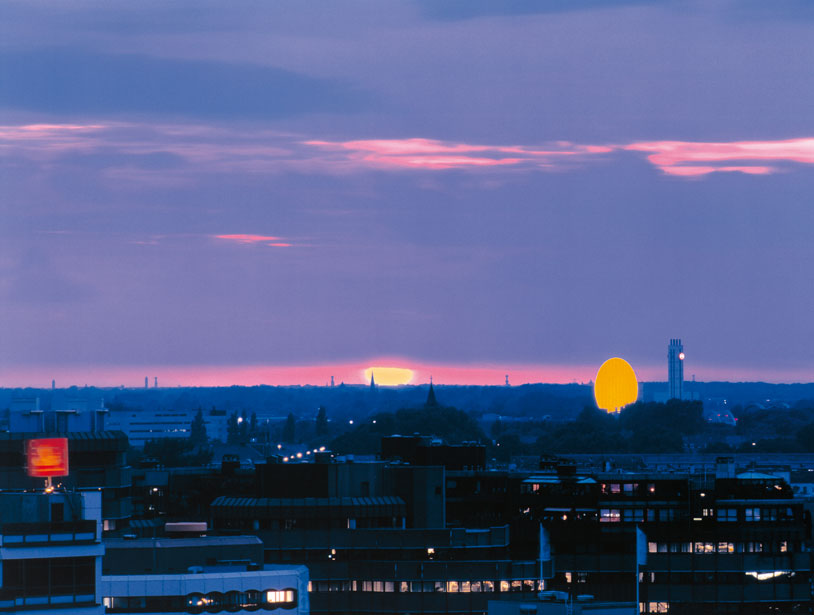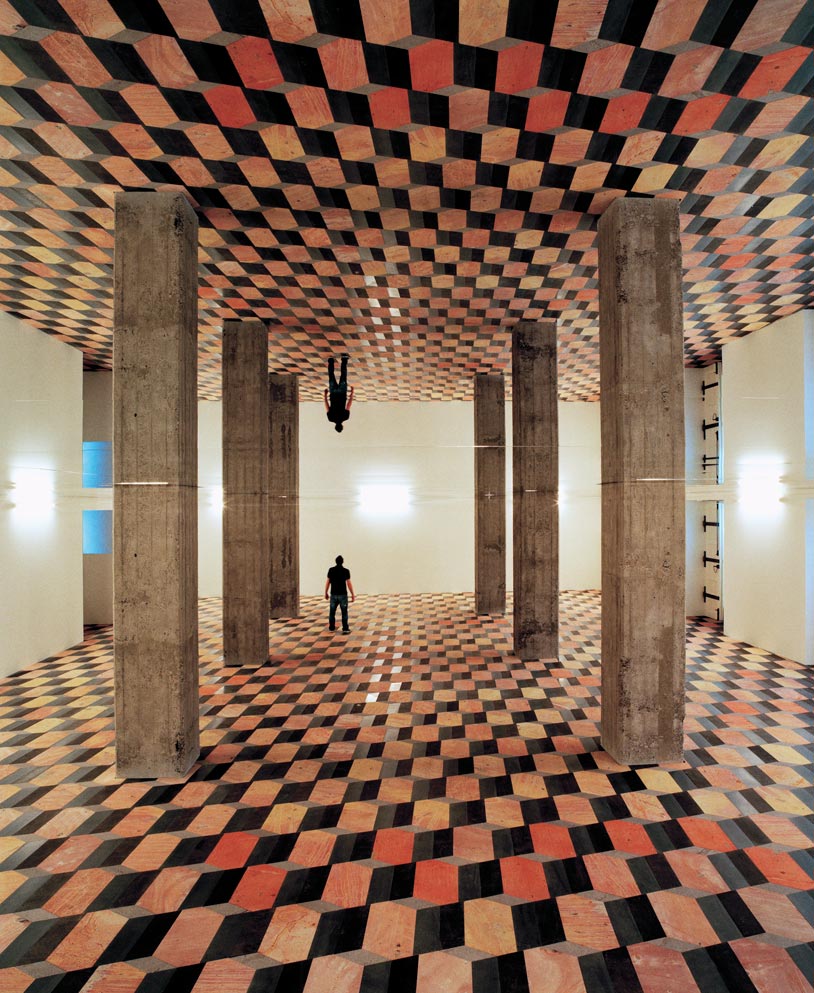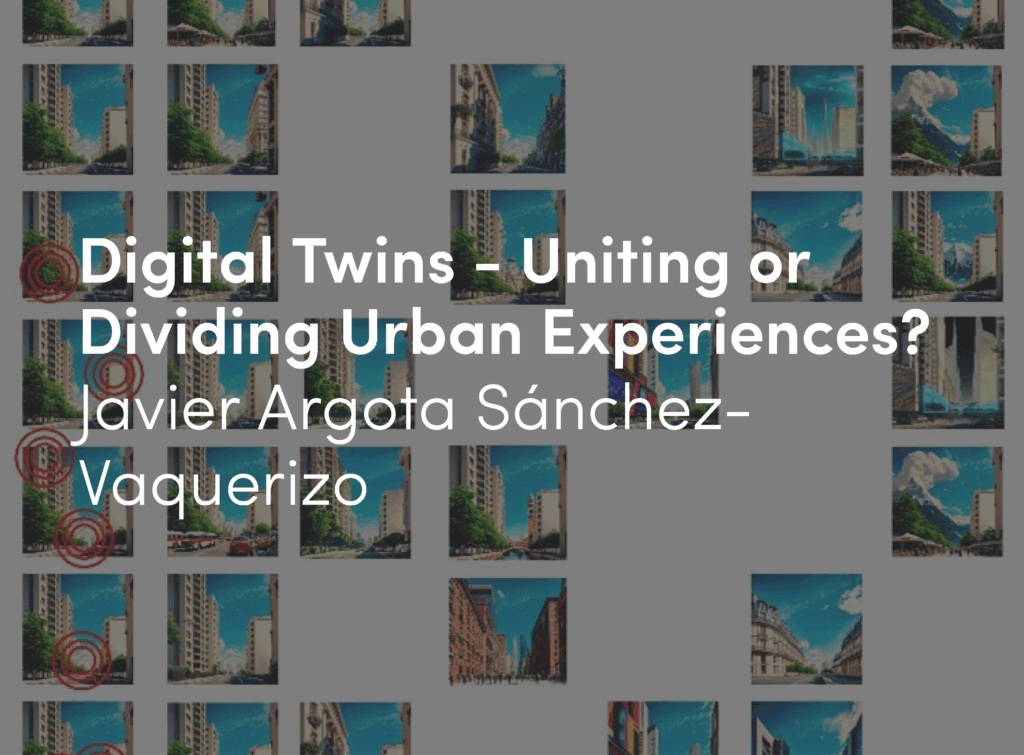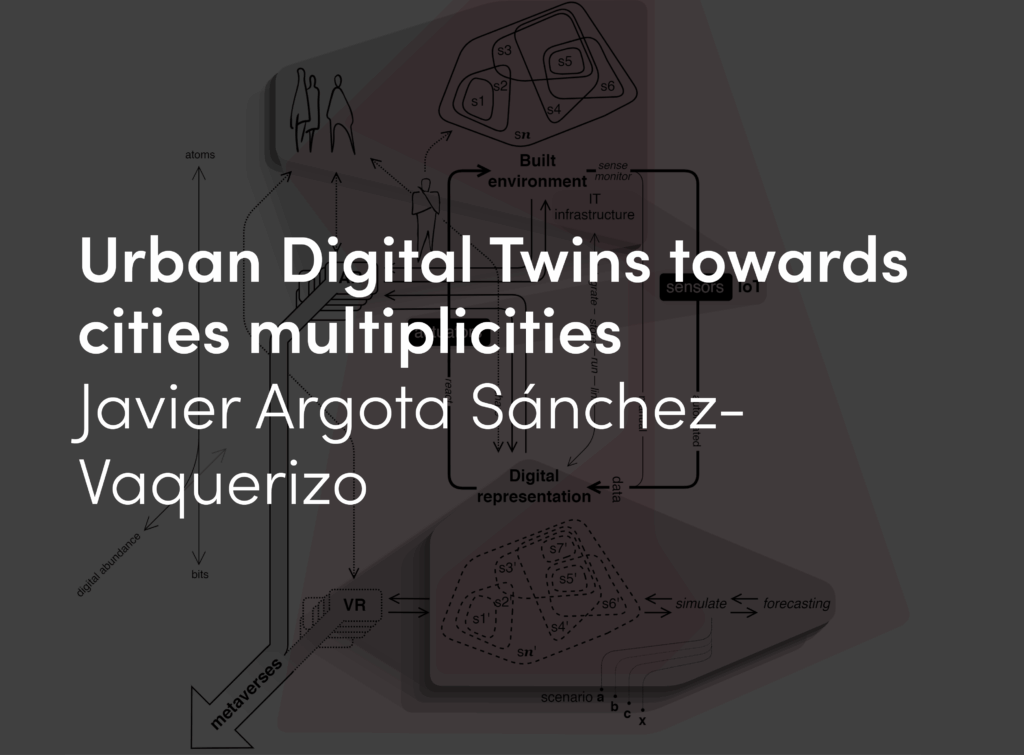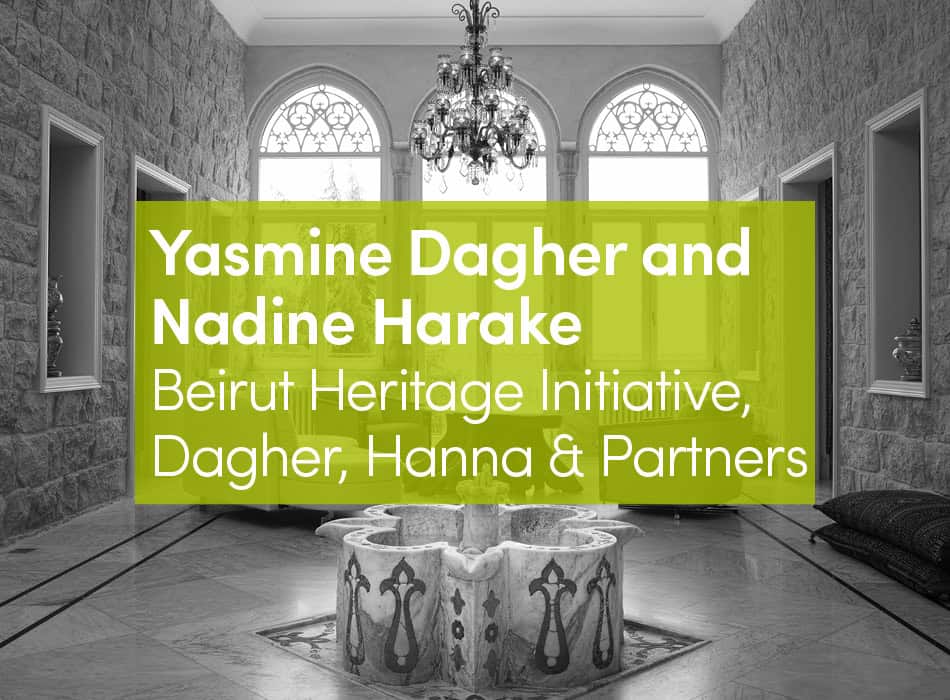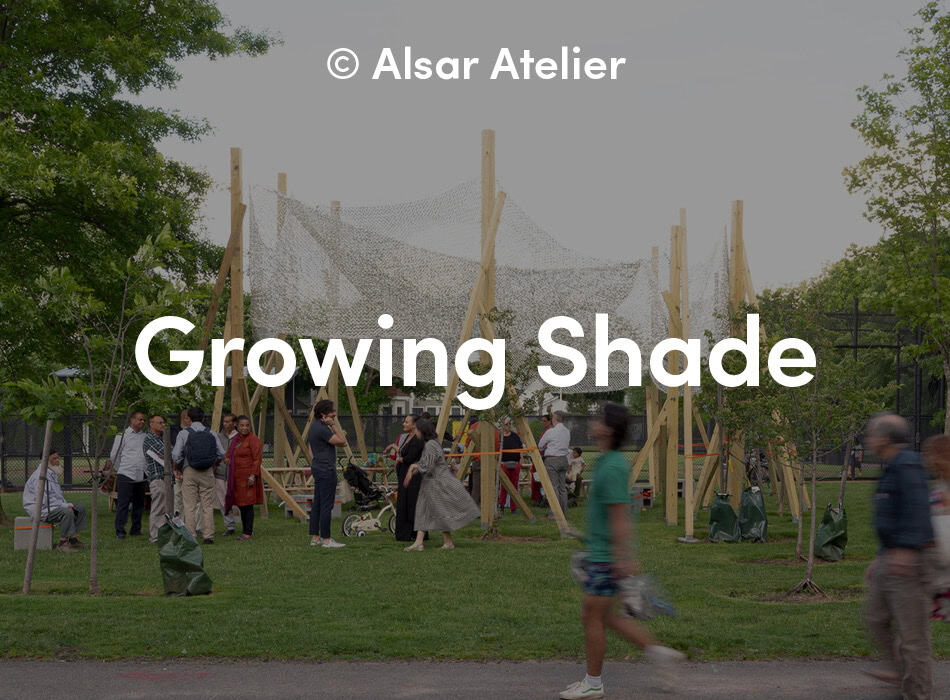Conversation between Olafur Eliasson and Florian Sauter.
Model room, 2003, in cooperation with Einar Thorsteinn, Reykjavik Art Museum – Hafnarhus, 2004.
Florian Sauter In the catalogue for your exhibition “The mediated motion” at the Kunsthaus in Bregenz you wrote that the weather is a part of the project.
Could you perhaps explain that in more detail?
Olafur Eliasson In my artistic practice I have been focusing on the dematerialization of the object, or the traditional notion of objecthood, which implies an emphasis on the importance of different types of contextual elements. In the Bregenz exhibition, which I did in collaboration with the landscape architect Günther Vogt, there was no distinct border or threshold between the works that I and Günther created for the exhibition, the architecture of the museum, made by Peter Zumthor, the street space outside the building, and even the weather. What I would like to suggest is that an exhibition, whose central part is its experiential properties, includes the whole environment in which it takes place. In this case, the environment was not just the weather, but also the socio-political conditions of Bregenz. The weather was not more important than anything else, but as the show was above all oriented towards natural phenomena, the weather seemed an appropriate dimension to include.
F.S. The weather forecast used to be decisive for man’s survival. Looking at your work it is striking that this existentialist vision no more seems to be in the foreground, but rather a theatrical staging of climatic events. Would you agree that some of your projects can be interpreted as an artificial representation of the environment?
O.E. Well, the skill to foresee the weather was previously related directly to immediate survival. On a cold night one would need to take shelter and during summer one would be able to predict the quality of the crops for harvesting. Throughout history we have developed very different ways of engaging with the climate. In modernity, though, the distinct language involved in predicting the weather and the very direct relationship with it have become secondary, as production methods have proved that we can almost always create a successful crop. Efficiency in harvesting and agricultural methods meant that we, helped by a bit of rain and sun, could create the necessary conditions for a successful harvest. To sum it up, you could say that weather prediction has gone from being utilitarian and concerned with ones physical survival to becoming a more conceptual, psychological practice. It implies a colonization of time – a colonization of the near future. I think weather prediction today has become a metaphor for the desire to control the weather. If it is foreseeable, it is also somehow manageable.
When you engage in and establish a relationship with your surroundings, it has consequences both for you and the surroundings. My interest is to focus attention on this sense of causality. Of course I am generalizing a bit, but the idea of “Double sunset”, for instance, lies in the fact that it is clearly a construction – which may seem similar to the second world in The Truman Show.
Double sunset, 1999, Utrecht, 1999.
“What I would like to suggest is that an exhibition includes the whole environment in which it takes place.“
Actually, I do not think it is a parallel world, but a world inside our world.
This is an important difference. Perhaps one could say that Modernism, from which a general concept of space was developed, really focused on one-way communication instead of an exchange. The idea that the friction between you and your surroundings is a defining element of space was not cultivated until the late 1980s and 1990s through philosophers such as Deleuze, and with the reintroduction of phenomenology. This has opened up for a greater complexity in the notion of space. So I do not refer to the installations I create, including these artificially produced natural phenomena, as being outside or parallel to society. I would say they are microscopic engagements with and in society. And, what I think is maybe the most important aspect, they are producers of reality.
The weather project, 2003, The Unilever Series, Turbine Hall, Tate Modern, London, 2003.
“There is no direct boundary between what I do, what the architect has done, what I think, what the architect has been thinking, what the curator thinks, what the director is thinking, what the audience is thinking, and what the people in the restaurant selling sandwiches to the people visiting my show are thinking.“
F.S. In the context of what you just said, regarding nature and society from this more general point of view, two opposing ideologies might be ascribed to exist defining man’s relation towards nature. The first one, an ideological doctrine, refers to nature as a deterministic concept in which man is able to totally decipher its modes of production. The other is more physical or materialistic and regards man as being an adaptive part of the natural evolution. In philosophical terms, do you regard man as being a part of nature or above it?
O.E. Well, I find nature as such a very questionable concept. Every time we discuss nature we tend, more or less consciously, to introduce a hierarchy of what is beautiful, what is good, and so on. In our society, which still retains some of Modernism’s ideals, we have not yet cultivated the polyphony with which we need to handle the notion of “nature”. By polyphony I mean the fact that contradictory ideas about nature may coexist. If we did not embrace the complexity of nature, we would simply develop a new form of totality. In traditional artistic discussions one will encounter a history of nature that includes problematic concepts such as “Hohe Schönheit” and the sublime. Nature has been a carrier of symbolic or religious content. The concept should therefore be used with caution. Perhaps architecture has a more profound relationship with nature due to the environmental challenges that it has quite successfully dealt with during the last thousand years. The relation between object or building and nature differs from that between an artwork and nature.
F.S. In Latin, there exists the dialectic between natura naturans, the producing nature, and natura naturata, the produced nature. Throughout the history of art, foremost painting and sculpture rather copied nature in its formal appearance, and architecture rather employed its principales of growth.
Your work might be positioned at a border zone between art and architecture. What is your response to that?
O.E. I agree with you that I work in-between the two. But I actually do not find representation superficial. To me representation is real. I would argue that the representational aspect of the world is more real than the romantic idea of the real. When recreating natural phenomena in nature or indoors, such as my waterfall, which consists of scaffolding, a hose, pump, and water, I can claim that it is as real as any waterfall – the ones in the Alps, for instance. It is falling water, while still being a representation.
To be honest, I am not all that interested in nature. I am interested in people, in how people perceive themselves and their surroundings; in what gives people a sense of identity, a sense of self, of responsibility, tolerance – I could go on like this. In order to investigate this I need a language. If we stick to the term nature – which I have always been slightly sceptical about – it may be understood as a very open language that allows for great individual interpretation. To put it simply: I use nature as a language to express the things about people that interest me. When I do a rainbow in a garage, it is not that rainbows fascinate me particularly. I am interested in what the experience of the ephemerality of the rainbow does to you. For me natural phenomena may instigate a re-evaluation of the ideas we have about ourselves – which I find very exciting.
Waterfall, 1998, Neue Galerie Graz am Landesmuseum Joanneum, 2000.
F.S. In relation to the creative will of the artist, you frequently described the observer as being creative too. In a certain way he or she finishes the work.
O.E. I have always emphasized the importance of the spectator, the user, or the participant in my work – they are central elements. There are a few reasons for this. First of all one has to recognize that the communicative history of art – I mean the communication of art in museums and elsewhere, the rules regarding the art object and the user, has been very rigid. One of the first things that struck me when I started working with art was how organized the art system was. There were specific ways of perceiving, experiencing, and handling art. I then quickly became involved in discussions of performativity. Instead of looking at artworks as objects, as Modernity had suggested, we considered the performative aspect of the cultural context in which this object was experienced. The dematerialization of objecthood in art thus became a political issue and an institutional challenge. So dematerialization is not a formal act – it is
a socio-political or even geopolitical action. It is not about making new rules, but rather about understanding that rules are constantly being renegotiated.
In one situation we might well be able to use the existent practice of displaying an object in a glass case in a traditional museum. But that very same object might in a different context require a completely different ideology of display. This brings me to the issue of the observer again, a term I actually do not use very often, because it implies passivity. Institutional systems such as art museums often consider their visitors to be observers. I, of course, prefer to think about the visitor as a producer. If you produce your own reality, you also have to consider your responsibility in doing so. If you simply observe the world, you appear to be less responsible, because the world just flies by you.
Frost activity, 2004, Reykjavik Art Museum – Hafnarhus, 2004.
“I prefer to think about the visitor as a producer. If you produce your own reality, you also have to consider your responsibility in doing so.“
F.S. Forcing the viewer to shift the focus of his experience from the object to the action itself, only his own relative, subjective perception seems of importance. Could you explain what importance “movement” in general has in your work?
O.E. Movement has not been a central issue in art and architecture history. I find that time is the key to our engagement with space as it gives everything else a degree of relativity. There is a far-reaching economy organized around non-relative objects today. Take the car industry, for instance: it has always emphasized the importance of presenting its cars as being of universal quality and timeless design. It tries to establish a non-negotiable idea of the object.
Let us return to Bregenz now. Calling the show “The mediated motion”, I first of all wanted to focus on the fact that it is mediated, a representation. This is an important issue, because Zumthor seems to have a rather ambiguous relationship with what is real and what is not. One could say that he sometimes eliminates temporality. However, at times he is not wrong and he does introduce arguments that I find very healthy for spatial theory today. In “The mediated motion” time is a producer of the exhibition and its reality. Your movement through the show becomes the way you mediate and create it. I saw this bus full of architectural students visit the museum: they walked into Zumthor’s space and moved about in a very strict manner, like in a coordinate system. They did not perceive the temporality that I actually think Zumthor has put into the building by distributing staircases and columns in a specific way.
The mediated motion, 2001, in collaboration with Günther Vogt, Kunsthaus Bregenz, 2001.
“Your movement through the show becomes the way you mediate and create it.“
F.S. Your sculptures and installations don’t appear as “beautiful” objects in a classical manner, but rather as the “strangely” looking results of your staging processes. Do you regard your creations as art objects or as scientific machines to produce certain poetical effects?
O.E. Well, obviously I consider my objects as artworks, as I am an artist, not a scientist. I would not call the spaces I do architecture. They are artworks. But this does not mean that I cannot engage in scientific experiments or an architectural practice – I simply do it from the viewpoint of an artist. Actually the question, whether something is art or not has become obsolete, because no qualities are added to an object by calling it art. The reality production that is connected to a certain art machinery is not as dependent on the term “art” as it was thirty or forty years ago. In that sense I am rather relaxed about whether something is art or not. But I do think that artistic research and content, art as a socio-critical endeavour, is being marginalized even though the art market today is stronger than ever. It is therefore extremely important that art claims its territory.
Beauty, 1993, ARoS Aarhus Kunstmuseum, 2004.
”Actually the question, whether something is art or not has become obsolete, because no qualities are added to an object by calling it art.”
F.S. Your exhibitions have been shown in some of the most iconic museums in Europe. Considering the interaction of art and architecture, is it inspiring for you to work in such places and do you react specifically towards them?
O.E. I typically prefer museums whose architects have created a signature, even though this signature may sometimes be counterproductive to the art being exhibited. Often my interventions take on architectural dimensions. Sometimes my work consists of simply adding an extra wall with a hole in it, through which light is emitted into a space, or the cutting of a hole in an already existent wall or ceiling. As we have already discussed, spaces are made up of various elements and relations. When I enter any kind of space, a museum for instance, there is no direct boundary between what I do, what the architect has done, what I think, what the architect has been thinking, what the curator thinks, what the director is thinking, what the audience is thinking, and what the people in the restaurant selling sandwiches to the people visiting my show are thinking. I try to emphasize this holistic approach in order to avoid giving the object the status of an icon.





